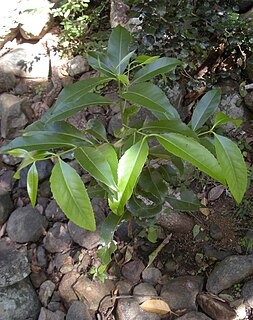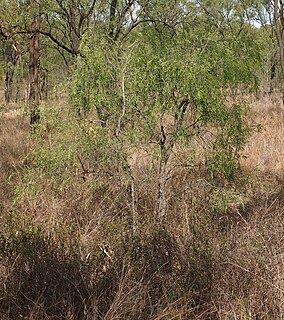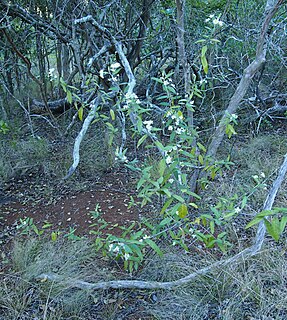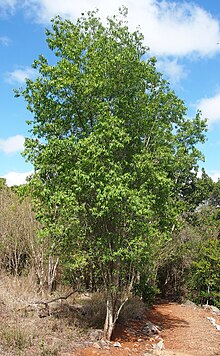Pilidiostigma is a genus of shrubs and small trees in the myrtle family Myrtaceae. All species occur in Australia and one, P. papuanum, also occurs in Papua New Guinea. They are not generally known to horticulture. The species P. sessile is rare.

Eupomatia laurina, commonly named bolwarra or sometimes native guava or copper laurel, is a species of shrubs to small trees, of the Australian continent ancient plant family Eupomatiaceae. They often grow between 3 and 5 m tall, larger specimens may attain 15 m (50 ft) and a trunk diameter of 30 cm (12 in). They grow naturally in eastern Australia and New Guinea. In Australia, they grow as far south as Nowa Nowa in the humid forests of the warm temperate east of the state of Victoria through eastern New South Wales and Queensland north to tropical Cape York Peninsula. They are one of the ancient lineages of flowering plants, usually growing as part of an understorey in rainforests or humid Eucalypt forests.

Diospyros humilis, commonly named Queensland ebony, is a small eastern Australian tree found throughout Queensland and extending into Northern New South Wales and the Northern Territory. The plant is most commonly found in coastal and semi-arid zones in vine scrubs, brigalow woodlands and other locales with infrequent fire.

Breynia oblongifolia, commonly known as coffee bush, grows naturally in Australia and New Guinea as shrubs up to 3 m (10 ft) in height. The species produces alternate, ovate leaves 20–30 mm (0.8–1.2 in) long. Small, green flowers are produced in spring and summer, and these are followed by orange or pink berries about 6 mm (0.24 in) diameter that turn black when fully ripe.

Jagera pseudorhus, commonly named foambark, is a species of rainforest trees, in the northern half of eastern Australia and in New Guinea, constituting part of the flowering plant family Sapindaceae. Named for the saponin foam that forms on the bark after heavy rain.

Cryptocarya triplinervis is a rainforest tree growing in eastern Australia. Common names include the three veined laurel, three veined cryptocarya and the brown laurel.

Trophis scandens, commonly named burny vine, is a species of large woody vines, constituting part of the fig plant family. They grow naturally in rainforests in Australia and Malesia.

Maclura cochinchinensis, commonly known as cockspur thorn, is a species of vine or scrambling shrub in the family Moraceae. The native range extends from China, through Malesia and into Queensland and northern New South Wales. The species inhabits various types of tropical forest: most commonly in monsoon forests. The globular, yellow or orange fruit are sweet and edible and were a traditional food source for Australian Aborigines.

Gmelina fasciculiflora, known as the northern white beech is a species of trees endemic to the Queensland tropical rain forests, Australia, of the mint (Lamiaceae) plant family. It is one of four recognised species of the genus Gmelina found in Australia.

Hedraianthera is a genus of a sole recognised species of shrubs or small trees endemic to Australia from the family Celastraceae.
Rhodomyrtus macrocarpa is a species of the botanical family Myrtaceae. It grows into a tree, native to north-east Australia, New Guinea and the Aru Islands, and is also known as wannakai, finger cherry, or Cooktown loquat.

Acalypha eremorum is a species of shrubs of the plant family Euphorbiaceae, endemic to Queensland, Australia. Commonly known as soft acalypha, turkey bush or native acalypha. The species grows as an open branched shrub to 2 m tall with small leaves with crenate margins. Plants may shed their leaves in response to prolonged drought. Branches often end in spines, especially on smaller plants. Small flowers are produced in spikes throughout the year and are followed by deeply lobed capsular fruit.

Elaeodendron melanocarpum is a species of shrubs or small trees endemic to northern Australia. The natural range extends from The Kimberley across The Top End to Cape York Peninsula and southwards to South East Queensland. The species occurs in monsoon forest and drier types of rainforests, commonly along streams.

Denhamia oleaster is a shrub or small tree within the family Celastraceae, endemic to Queensland. The species inhabits a variety of environments, from monsoon forest to semi-arid savanna and occurs on a broad range of soil types. In more humid locales the species can grow to 6 metres in height, although it may not reach more than 1 metre in less favourable environments.

Maytenus cunninghamii is a species of shrub endemic to Australia. The natural range extends from The Kimberley and throughout The Northern Territory and Queensland. The plant grows to 6 metres in height, though it commonly flowers as a much smaller shrub. It is most commonly found in savanna and open forests, though it occasionally extends into monsoon forest.

Olearia canescens is a shrub belonging to the family Asteraceae. Commonly known as Grey Olearia, Grey Daisy Bush or New England Daisy Bush, the species is endemic to Eastern Australia, growing in monsoon forests and drier rainforest types from North Queensland to northern New South Wales. O. canescens can grow as a woody shrub up to 6 metres in height, an unusual habit for a member of the daisy family. However it more commonly exists as a low shrub of 2 – 4 metres with only a slightly woody form.

Exocarpos latifolius is a species of parasitic trees, of the plant family Santalaceae. They have the common names broad leaved ballart, scrub sandal-wood, scrub cherry, oringorin, broad leaved cherry or native cherry. The species is found in monsoon forest, littoral rainforest and occasionally in more open forest types in Malesia and across Northern Australia.

Cassia brewsteri, commonly known as Brewster's Cassia, Leichhardt Bean, Cassia pea and Bean Tree is a species of leguminous shrubs or small trees, of the plant family Fabaceae. They grow naturally in Queensland, Australia. They primarily grow in open forest, and occasionally in monsoon forest.

Lithomyrtus obtusa, commonly known as beach myrtella, is a flowering plant species in the myrtle family, Myrtaceae. It occurs in coastal areas in New Guinea and Queensland, Australia.

Australian Tropical Rainforest Plants, also known as RFK, is an identification key giving details—including images, taxonomy, descriptions, range, habitat, and other information—of almost all species of flowering plants found in tropical rainforests of Australia, with the exception of most orchids which are treated in a separate key called Australian Tropical Rainforest Orchids. A key for ferns is under development. RFK is a project initiated by the Australian botanist Bernie Hyland.



















